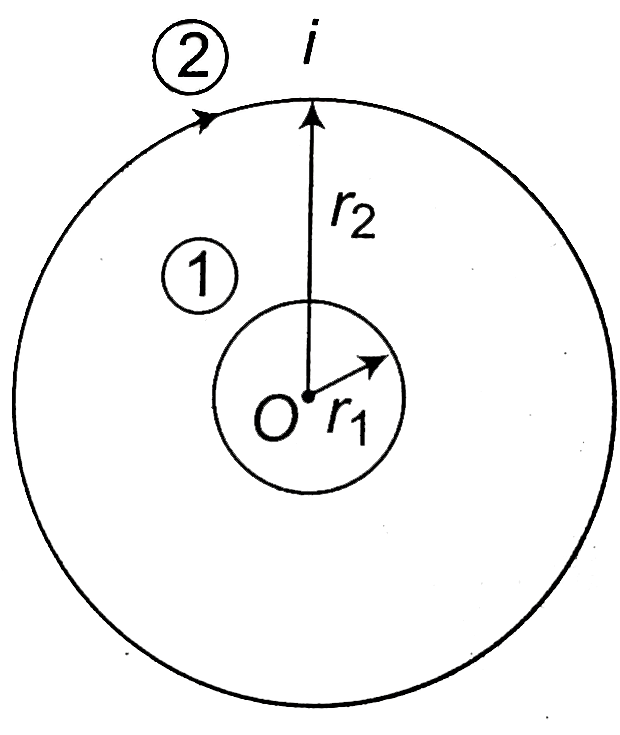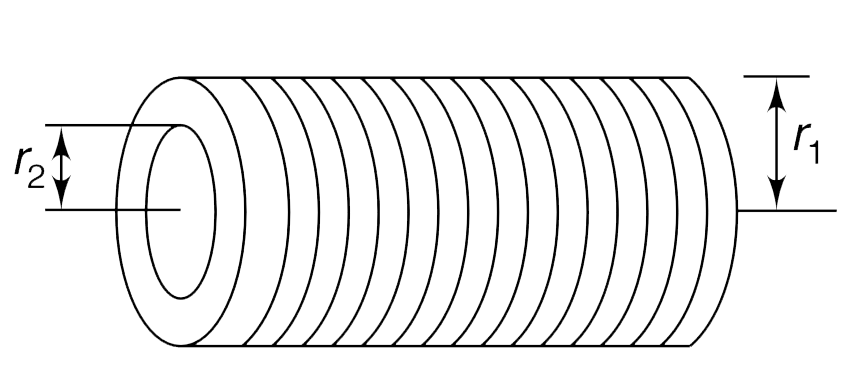Two concentric coplanar circular loops made of wire, with resistance per unit length λ , have radii rI and r2(r2>>rI) . A potential difference (α+βt) is applied to the larger loop, where t is time. Calculate current in the smaller loop.
Current in the larger loop i=α+βtr2 R2 : resistance of larger loop
Magnetic field due to larger loop at centre B2=μ0i2r2n (assumed uniform in loop(1))
Flux through smaller loop
ϕ1=B2A1=μ0i2r2.πr21=μ0(α+βt).πr212r2R2
Induced emf in loop (1)
e1=dϕ1dt=μ0βπr212r2R(2)
Current in smaller loop
i1=e1R1=μi0βπr212r2R1R2
R1=λ.2πr1 , R2λ.2πr2
i1=(μ0βπr212r2.2λπr1.2λπr2)
=μ0brtar218λ2πrrr

Topper's Solved these Questions
Similar Questions
Two concentric coplanar circular loops made of wire with resistance per unit length 10−4Ω/m, have diameters 0.2 m and 2m. A time varying potential difference (4+2.5t) volt is applied to the larger loop. Calculate the current in the smaller loop.
View SolutionTwo concentric coplanar circular conducting loops have radii R and r(R>>r) .Their mutual inductance is proportional to
View Solution
Knowledge Check
Two concentric coplanar circular loops of radii r1 and r2 carry currents of respectively i1 and i2 in opposite direction (one clockwise and the other anticlockwise). The magnetic induction at the centre of the loops is half that due to i1 alone at the centre. if r2=2r1. the value of i2/i1 is
A2B1/2C1/4D1Two concentric circular loops of radiir1 and r2 carry clockwise and anticlockwise currents i1 and i2. If the centre is a null point, i1/i2 must be equal to
Ar2/r1Br22/r21Cr21/r22Dr1/r2A circular conducting loop of radius r0 and having resistance per unit length λ as shown in the figure is placed in a magnetic field B which is constant in space and time. The ends of the loop are crossed and pulled in opposite directions with a velocity v such that the loop always remains circular and the radius of the loop goes on decreasing, then
 Aradius of the loop changes with r as r=r0−vtπBemf induced in the loop as a function of time is ε=2Bv[r0−vtπ]Ccurrent induced in the loop is I=Bv2πλDcurrent induced in the loop is I=Bvπλ.
Aradius of the loop changes with r as r=r0−vtπBemf induced in the loop as a function of time is ε=2Bv[r0−vtπ]Ccurrent induced in the loop is I=Bv2πλDcurrent induced in the loop is I=Bvπλ.
A portion of length L is cut out of a conical solid wire the two ends of this portion have circular cross - sections of radii r1andr2(r2>r1). It is connected lengthwise to a circuit and a current I is flowing in it The resistivity of the material of the wire is ρ . Calculate the resistance of the considered portion and the voltage developed across it .
View SolutionA very small circular loop of area 5×I0−4m2 , resistance 2Ω and negligible inductance is initially coplanar and concentric with a much larger fixed circular loop of radius 0.Im . A constant current of IA is passed in the bigger loop and the smaller loop is rotated with angular velocity ωrad/sec about a diameter. Calculate (a) the flux limked with the smaller loop, (b) indced emf (c) induced current in the smaller loop, as a function of time.
View SolutionTwo long co-axial solenoids have radii, and number of turns per unit length equal to r1,r2 and n1,n2 respectively where suffix 1 refers to the outer solenoid and 2 refers to the inner solenoid. Length of both is l. The current in the outer solenoid is made to grow as I1=kt where t is time. Resistance of the wire used in inner solenoid is R. Write the current induced in the inner solenoid assuming that it is shorted.

View SolutionA very small circular loop of radius r is initially coplanar and concentric with a much larger circular loop of radius R(>>r) . A constant current i is passed in the larger loop which is kept fixed in space and the small loop is rotated with angular velocity ω about a diameter. The resistance of the small loop is R0 and the inductance is negligible.
(a) Find the current in the small loop as a function of time.
(b) Calculate how much troque must be exerted on the small loop to rotate it.
View SolutionA circular loop of radius R carries a current I. Another circular loop of radius r(ltltR) carries a current I. The plane of the smaller loop makes an angle of 30^@ with that of the larger loop. The planes of the two circles are at right angle to each other. Find the torque acting on the smaller loop.
View Solution
